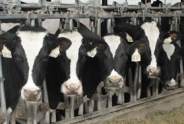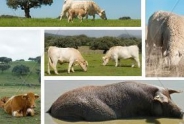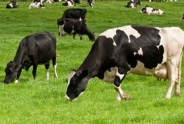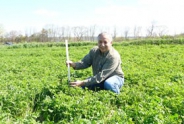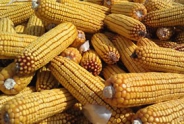Implementing Biosecurity on Dairy Farms
Jackson Wright, Dairy
Northwest New York Dairy, Livestock & Field Crops
March 1, 2013

Moreover, biosecurity can be somewhat intangible because it is often referred to in the context of a catastrophic event such as an outbreak of foot and mouth disease (FMD). However, New York State is currently experiencing an increased incidence in Salmonella Dublin. Salmonella Dublin is a bacteria that generally manifests itself as respiratory disease in calves and can cause permanent lung damage. In addition, Salmonella Dublin is a zoonotic disease which means that it can spread from cows to humans. This recent outbreak should act as a reminder of the importance of implementing biosecurity principles into our daily practices.
To practically incorporate biosecurity on dairy farms, it's important to understand how diseases spread. Many diseases spread through the fecal-oral route, or in other words when cows ingest manure. As a result employees should avoid walking in animal feed if their boots are contaminated with manure. Similarly, equipment should be designated to handle only feed or only manure. In addition, calves are the most vulnerable animals on the farm; therefore, implementing, a boot wash before entering any calving facilities or calf barns can be a practical solution. Being conscious of this route of infection should be the first step in implementing biosecurity.
Taking this a step further, many biosecurity plans involve the RITS principle. RITS is an acronym for Resistance/Recognition, Isolation, Traffic Control, and Sanitation. Resistance involves implementing a proper vaccination program. This should be developed with help from your herd veterinarian. Along with resistance it's important to realize that cows are constantly being bombarded with pathogens. Usually the cow's immune systems can keep these pathogens in check; however you can tip the balance in favor of the pathogens if animals are exposed to a high pathogen load or if animals are under stress. Stress factors such as overcrowding, heat stress, or facilities lacking in cow comfort can suppress the immune response, allowing pathogens to proliferate and cause disease. This can be a vicious cycle because once animals actively show disease symptoms they are usually simultaneously shedding the disease into the environment, increasing pathogen load and perpetuating the cycle. It's also important to quickly recognize an outbreak, meaning if multiple animals are showing signs of disease action should be taken to minimize the spread of disease. Often this requires advice from your herd veterinarian and leads me to the "I" in RITS or isolating infected animals. If you are not maintaining a "closed" herd, purchased animals should come with vaccination records and test negative for Johnes, Leukosis, and Salmonella Dublin. New arrivals should be placed in isolation for at least two weeks to prevent any new disease from being introduced to the herd.
This can be difficult to implement but recognize that new arrivals are generally under a lot of stress from transportation and experiencing a new environment. Therefore, should they be a carrier animal they will likely begin actively shedding a disease into the environment. If they are a healthy animal they will likely be more susceptible to new infections because their immune system is suppressed. The "T" involves traffic control. Employees should move from the youngest animals to older animals, working from healthy animals to sick animals. This movement pattern reduces the pathogen load for healthy animals. Traffic control also includes visitors to the farm. Visitors should have a clear parking area that directs them to an employee or a manager who can facilitate their movement around your facility. Worst case scenario is when visitors can access any part of your operation, petting lactating cows and then visiting the calf barn to have the baby calves suck on their hands. This poses a threat to the health of your calves and a threat to the health of the visitor because calves can carry several zoonotic diseases, including cryptosporidium. Finally, this leads me to the "S" or sanitation. People who care for sick animals should change clothes before working with healthy animals or calves. They should also be provided with a hand washing station or hand sanitizer. This provides protection to both other animals and to your employees.
Upcoming Events
Dairy Systems & Technology Showcase - Cortland County Tours
November 5, 2025 : Fall Farm Tour - Cortland County
- Guided facility walk through of new dairy systems and technologies on farms across NYS led by CCE Dairy Specialists, PRO-DAIRY, and other industry experts.
- Intended audience: Dairy farmers and industry partner
Spanish Dairy Webinar Series
September 3, 2025
September 10, 2025
September 17, 2025
September 24, 2025
October 1, 2025
October 8, 2025
October 15, 2025
October 22, 2025
October 29, 2025
November 5, 2025
Daniela Gonzalez Carranza is happy to announce a collaboration with the University of Wisconsin-Madison for a dairy webinar series only in Spanish.
Beef Quality Assurance - Training Day
November 15, 2025 : Beef Quality Assurance - Training Day
Announcements
USDA Contract Freezes and Terminations: Legal Action Steps for Farmers
For Farmers with Signed EQIP and CSP ContractsThis resource is written for farmers and ranchers nationwide who have a signed contract with USDA NRCS under the EQIP or CSP program for environmental improvements but have concerns that their contract is frozen, under review, or terminated, and who are uncertain of their rights to receive reimbursement as well as their ongoing obligations under the signed contract.
Version: 1.0
Issue date: Feb 28, 2025
A downloadable factsheet is available at our BUSINESS tab on the top of our webpage.
Additional Information: www.farmcommons.org
USDA Contract Freezes: Filing an NAD Appeal or Demand Letter
This resource is written for farmers and ranchers nationwide who have a signed contract with USDA NRCS under the EQIP or CSP program for environmental improvements and want more information on the mechanics of filing a National Appeals Division (NAD) appeal. This resource includes sample letters.
USDA NAD Appeal https://www.usda.gov/about-usda/general-information/staff-offices/office-hearings-and-appeals/national-appeals-division/nad-appeals
A downloadable factsheet is available at our BUSINESS heading at the top of our webpage.
Farm Participants Needed for Bale Grazing Grant!
Information on the Project:- Approximately 10 acres total needed to bale graze two different bale densities
- "Core" farms will graze two winters, "Demo" farms will graze one winter.
- Payments for both "Core" farms and "Demo" farms
- Baseline soil sampling by bale grazing team
- Forage measurements in early season by bale grazing team
- Late season clipping if residual not trampled down by farm
Interested farms can enroll for this winter or next.
Looking for 2-3 dairy farms to enroll! If interested, please reach out to Betsy Hicks, 607.391.2673 or bjh246@cornell.edu
Cornell Cow Convos - New Podcast
On-going podcast, New episodes released on the last Thursday of the month.Guest speakers, CCE Dairy Specialists.
Housed on Soundcloud Channel is CCE Dairy Educators
Topics:
- Preventative healthcare for cows
- The trend of beef on dairy
- What to look forward to in the new year for dairy
- Socially grouping or pair-housing calves
2018 Drug Residue Prevention Manual
For more than 30 years, the U.S. dairy industry has focused educational efforts on the judicious use of antibiotics through the annual publication of a Best Practices Manual. The 2018 edition of the National Dairy FARM Program: Farmers Assuring Responsible Management? Milk and Dairy Beef Drug Residue Prevention Manual is the primary educational tool for dairy farm managers throughout the country on the judicious and responsible use of antibiotics, including avoidance of drug residues in milk and meat.The manual is a quick resource to review those antibiotics approved for dairy animals and can also be used as an educational tool and resource for farm managers as they develop on-farm best management practices necessary to avoid milk and meat residues. Visit the Manual and Form Library to download copies of this important tool!
Follow us on Facebook
The team updates our facebook page frequently - follow us to be updated on our events, see some fun videos and get local area updates!facebook.com/SCNYDairyandFieldCropsTeam
NYSERDA Agriculture Energy Audit Program
NYSERDA offers energy audits to help eligible farms and on-farm producers identify ways to save energy and money on utility bills. Reports include recommendations for energy efficiency measures.Eligibility
Eligible farms include but are not limited to dairies, orchards, greenhouses, vegetables, vineyards, grain dryers, and poultry/egg. The farms must also be customers of New York State investor-owned utilities and contribute to the System Benefits Charge (SBC). Please check your farmís current utility bills to see if your farm pays the SBC.
Energy Audit Options
You can request the level of energy audit that best fits your farmís needs. NYSERDA will assign a Flexible Technical Assistance Program Consultant to visit your farm and perform an energy audit at no cost to you.
For more information and the NYSERDA Agriculture Energy Audit Program Application click here
For more information and the NYSERDA Agriculture Energy Audit Program Application click here

